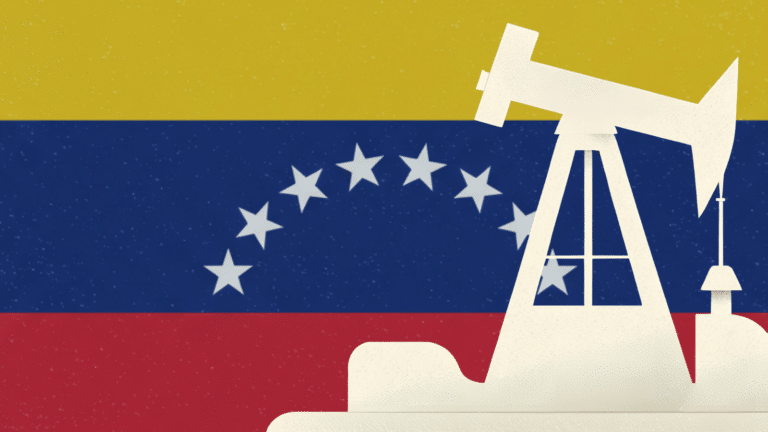This Energy Explained post represents the research and views of the author. It does not necessarily represent the views of the Center on Global Energy Policy. The piece may be subject to further revision. Contributions to SIPA for the benefit of CGEP are general use gifts, which gives the Center discretion in how it allocates these funds. Rare cases of sponsored projects are clearly indicated.
For a full list of financial supporters of the Center on Global Energy Policy at Columbia University SIPA, please visit our website at Our Partners. See below a list of members that are currently in CGEP’s Visionary Circle. This list is updated periodically.
The sweeping new sanctions imposed on Russia’s energy sector by the Biden administration on January 10 mark a significant shift in strategy. Since the start of Russia’s full-scale invasion of Ukraine, the administration has attempted to balance two competing objectives: maximizing economic pressure on Russia while minimizing disruptions to global energy markets. As a result, President Joe Biden previously avoided sanctions that could significantly impact global oil and gas supply, fearing the ramifications for energy prices and inflation. But now, with energy markets well supplied and inflation under control, Biden has pivoted to a more aggressive approach, one that could substantially reduce Russia’s energy exports. In the short term (1-2 months), sanctions could reduce Russia’s oil exports by 0.5 to 1 million barrels per day (bpd) and widen discounts for Urals crude (on FOB Primorsk and FOB Novorossiysk bases) to Brent (North Sea Dated), as happened at the beginning of 2023 following the introduction of the price cap, by $20 per barrel (up from $12 per barrel in December 2024 to $35 per barrel). Unless the incoming Trump administration maintains the pressure, however, Russia’s oil export volumes could recover much of their losses by Q2, and discounts will gradually stabilize. This Q&A examines these new sanctions and their potential impact on global energy markets.
What did the US target in the new sanctions?
The new US sanctions target Russia’s energy sector from multiple angles. Key measures include:
- Blocking sanctions on Gazprom Neft and Surgutneftegas: These are Russia’s third- and fourth-largest oil producers, representing approximately 2.5 million bpd of output and 1 million bpd of exports. This marks the first time the United States has directly sanctioned major Russian oil companies.
- Designations on 183 oil tankers: The sanctions target vessels in Russia’s “shadow fleet,” which has been used to bypass the oil price cap.
- Ban on oilfield services: The United States has prohibited the provision of all oilfield services to Russia, a move aimed at curbing its long-term energy production capacity.
- Sanctions on two actively producing liquefied natural gas (LNG) facilities: Previously, the United States had only sanctioned non-operational Russian LNG projects such as Arctic LNG 2.
- Sanctions on Russian maritime insurers: The United States targeted top Russian ship insurers Ingosstrakh and Alphastrakhovanie.
- Phasing out a crucial general license for energy-related payments: Payments for Russian energy through US banks are now permitted only for wind-down purposes and will be fully prohibited starting March 12, 2025.
- Secondary sanctions: The United States sanctioned a Chinese oil terminal that facilitated a port call with a sanctioned Russian oil tanker.
How might the sanctions affect the price of Russian oil?
The new sanctions aim to reinforce the G7 oil price cap mechanism that has been in place since December 2022. The original price cap policy, which prohibited G7-based maritime insurers and shipowners from handling Russian oil priced above $60 per barrel, has gradually lost effectiveness due to structural design flaws. Specifically, the absence of secondary sanctions enabled Russia to develop an alternative supply chain, including its “shadow fleet” of hundreds of tankers operating outside G7 jurisdiction. Though these flaws were well-known, it took Russia several months to fully exploit them and undercut the efficacy of the price cap.
By targeting 183 tankers in this shadow fleet and a Chinese port operator that was working with the fleet, the new sanctions significantly constrain Russia’s ability to circumvent the price cap. Russia will now struggle to ship its oil exclusively using non-sanctioned vessels. Ports and refineries in China and India, the two biggest buyers of Russian oil, are unlikely to engage with sanctioned vessels due to compliance risks. Just days before the new sanctions, China’s Shandong Port Group banned US-sanctioned vessels from its network, and an Indian official suggested the same policyfor Indian ports.
To maintain export volumes, Russia seems to have two choices, at least in the short term: returning to using Greek-owned shipping firms that operate under G7 regulations, thereby forcing compliance with the price cap, or mobilizing alternative shadow fleet tankers in competition with Iran, which also relies on such vessels. In either case, these constraints are likely to result in wider discounts on Russian oil sales and higher transaction costs, effectively reducing Russia’s profit per barrel.
How might the sanctions impact Russia’s oil and gas export volumes?
Russian oil exports now face the most significant sanctions since the introduction of the European embargo and price cap at the end of 2022, when 1.3 million bpd was lost in a single month before workarounds allowed them to bounce back. Absent strict enforcement by the incoming Trump administration, these new sanctions could follow a similar trajectory.
- Blocking sanctions on Gazprom Neft and Surgutneftegas. Gazprom Neft and Surgutneftegas are among Russia’s top oil producers. They account for nearly 1 million bpd of Russia’s seaborne exports, most of which will likely halt as buyers and intermediaries assess compliance risks. In the short term (1–2 months), this will temporarily reduce Russia’s seaborne oil flows. In the medium term, workarounds are likely to emerge, such as third-party companies purchasing oil from the sanctioned firms via the Russian banking system and exporting it under their own names. Alternatively, there may be a redistribution of shares in the domestic market: non-sanctioned oil companies could maximize exports while Gazprom Neft and Surgutneftegas focus on domestic market supply. In recent years, Russia has fine-tuned these mechanisms for redistributing flows among its oil companies, leveraging its experience with OPEC+ and addressing internal fuel crises. While there are limits to this maneuver, it can alleviate part of the problem. However, these adjustments will likely take several months, during which some material reduction (200,000 to 400,000 bpd) in Russian oil exports is likely. In a couple of months, operational adjustments should allow for near-complete recovery, but increased costs and discounts will persist.
- Oil tanker designations. Taking into account the previously imposed restrictions, the US sanctions list now includes approximately 270–280 vessels, or about one-third of the total number of “shadow” tankers (820–850 vessels as of late December 2024) servicing the export of Russian oil outside of the price cap regime—representing capacity of about 2.6 million bpd. To address this challenge, Russia may accept lower volumes of crude exports, or revert to using Greek-owned shipping firms that operate under G7 regulations and price caps. In the coming months, immediate shortages in shipping capacity may increase transportation costs, cause delays, and reduce crude deliveries (by up to 300,000 to 500,000 bpd out of the 800,000 bpd affected). However, India is excluding ships chartered before January 10, provided they unload by March 12, effectively creating a two-month wind-down period to smooth the reduction in Russian volumes. In the medium term, Russia will likely adapt by expanding its shadow fleet through acquisitions, stabilizing export volumes.
- Ban on oilfield services. Sanctions on many Russian oilfield service companies and the ban on the provision of all oilfield services to Russia by US companies, together with sanctions on Rosneft’s flagship Vostok Oil project (a major Russian oil development project with exports that could supposedly reach 2 million bpd), should have limited immediate impact on ongoing production or exports. However, in the long term, especially in new fields or high-maintenance older wells, these measures will likely slow down or halt further development and gradually erode Russia’s oil output.
- Sanctions on two active LNG facilities. This is the first instance of direct targeting of operational LNG facilities (albeit the smallest ones so far, excluding Yamal LNG or Sakhalin), in addition to sanctions on LNG tankers. Russian LNG exports face greater challenges than oil due to fewer alternative buyers and logistical complexities. Around 3 billion cubic meters of LNG (based on 2024 exports) are targeted. Some of that LNG that used to go to Europe will probably stop, as Russia will likely redirect LNG shipments to countries like China. However, logistical challenges and required discounts will likely reduce profitability.
- Maritime insurance sanctions. The two Russian ship insurers that were sanctioned, Ingosstrakh and Alphastrakhovanie, provided insurance coverage for Russian oil exports and were previously accredited for the Indian market. Considering earlier restrictions on the insurance companies SOGAZ and RNPK, nearly the entire Russian oil export insurance segment is now under US sanctions. Russia can create several alternatives based on state-controlled financial groups, but that would also take time—at least a few months.
- Phasing out a crucial general license for energy-related payments. Disruptions in payment processing could lead to delayed shipments and payment disputes. This shift will further complicate trade while incentivizing a transition to alternative payment systems (e.g., yuan, rupee), albeit with higher transaction costs and risks.
With these new sanctions on insurers and on energy-related payments, it is likely that major buyers such as India and China will look for new opportunities for oil trade with Russia, including not only the transition to national currencies and insurance systems but also the establishment of dedicated logistics hubs to facilitate such exports. In other words, the formation of a fully independent financial and logistical system for trading Russian (and potentially Iranian) oil shipments with India and China, within the context of BRICS, is no longer a distant possibility but a tangible prospect in the coming months. The key question remains how attractive the level of discounts makes Russian oil for China and India compared to risk-free barrels from OPEC.
How is China likely to respond?
Chinese refiners are likely to pause their purchases of Russian oil as they wait to see how strictly the sanctions are enforced and look for ways to receive Russian oil on unsanctioned tankers. This initial caution seems to be reinforced byShandong Port Group’s announcement on January 7 that it is banning US-sanctioned tankers from its ports in Shandong Province, including Qingdao, Rizhao, and Yantai, which are points of entry for some of China’s Russian crude imports. The fact that tankers carrying Russian crude are idling off the coast of Shandong indicates that some Chinese refiners have already put their purchases of Russian crude on hold.
The new sanctions and Shandong Port Group’s ban are likely to prompt Chinese refiners to buy alternative crudes to avoid short-term supply disruptions. According to Kpler, the newly sanctioned tankers delivered around 600,000 bpd of Russian crude to China in 2024, accounting for about 61 percent on China’s seaborne imports of Russian crude. China’s national oil companies and large independent refiners have already begun to purchase cargoes of Middle Eastern crudes in response to the latest sanctions.
China’s small independent refiners known as teapots, which are concentrated in Shandong Province, are likely to be hard hit by the new sanctions. The teapots, which operate on thin margins, have relied almost exclusively on discounted sanctioned crudes from Russia, Iran, and Venezuela to be profitable. If the new sanctions raise the price of Russian crudes closer to the prices of similar unsanctioned crudes, some teapots may have trouble surviving.
Will the incoming Trump administration lift these sanctions?
Most of the new sanctions were imposed under Executive Order 13662, which was codified into law by the 2017 Countering America’s Adversaries Through Sanctions Act (CAATSA). This legal framework requires any presidential decision to lift the sanctions to undergo a 30-day congressional review period, during which Congress can block the action. Coupled with the Biden administration’s decision on January 15 to reissue hundreds of older sanctions under E.O. 13662, these actions mean that the Trump administration will find it hard to provide meaningful relief to Russia unless it can broker a deal that is minimally acceptable to Ukraine and its supporters in Congress.
Some have interpreted the use of E.O. 13662 as an effort to “Trump-proof” the sanctions, owing to concerns that Trump could ease off Russia and prioritize economic pressure on Iran and Venezuela. But it’s unclear whether the Trump administration will even seek to lift the sanctions. Several key figures in Trump’s incoming national security team, including National Security Advisor Mike Waltz, have publicly advocated for stronger sanctions on Russia’s energy sector, and incoming special envoy Keith Kellogg said recently that he expected a longer timetable for negotiations than Trump had indicated. Indeed, the sanctions will provide Trump with critical leverage in potential negotiations with Russian President Vladimir Putin to end the war in Ukraine.
The sanctions may also complement the Trump administration’s domestic energy agenda. Any reduction in Russian oil exports could increase global prices, potentially stimulating US energy production and exports. This effect would be magnified if the Trump administration also intensifies sanctions on Iran and maintains the current measures on Venezuela, as is expected. That said, if the Trump administration chooses not to enforce the sanctions vigorously, their impact on Russia’s economy—and global energy markets—could diminish quickly. The structure of US sanctions on Russia is hard to maintain without strong, regular enforcement measures, especially given Russia’s advantages in evasion due to its geographic size, energy importance, and geopolitical relationships. Imposing sanctions on Russian operators and their foreign enablers will be essential for sanctions to maintain pressure on Russian energy exports and the chill on foreign investment in Russian energy development. CAATSA may give Congress the power to keep sanctions on the books, but the level of enforcement will rest largely with the incoming Trump administration.
CGEP’s Visionary Circle
Corporate Partnerships
Occidental Petroleum
Tellurian
Foundations and Individual Donors
Anonymous
Anonymous
Aphorism Foundation
the bedari collective
Children’s Investment Fund Foundation
David Leuschen
Mike and Soa Segal
Kimberly and Scott Sheffield
Bernard and Anne Spitzer Charitable Trust
Ray Rothrock










